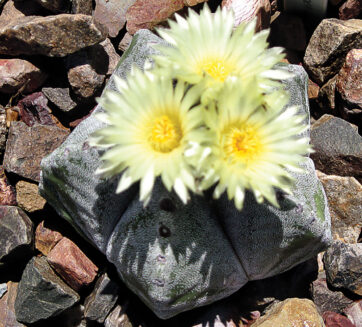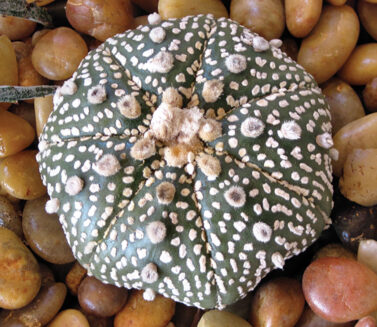Zann Wilson
ASTROPHYTUM CACTI
Most newcomers to desert gardening are put off by the many cacti that insist on fighting us with dangerous spines and glochids. It is refreshing to the aspiring gardener to find a cactus which is uniquely architectural in appearance and yet accepts a friendly touch without drawing human blood. Astrophytum myriostigma is such a plant. Bishop’s Cap, as it is commonly known, will stand up to our outdoor weather AND be a touchable beauty.
The common name, Bishop’s Cap, comes from its shape, which is similar to the hat a Bishop might wear. The shape is typically five-ribbed in a star pattern—hence the Greek name Astrophytum, which translates “star plant.” The species name of myriostigma implies “many marks.” The outer edges of each star segment are covered with white “trichomes” (hairy appendages) giving the plant a silvery patterned appearance.
Most Astrophytum are small, reaching a maximum of 18” in height. Slow growing, they will retain a somewhat spherical shape in the three to five inch size for many years. As these plants grow, they tend to elongate but still keep their unique star profile. They bloom with a pale yellow flower in the spring, and if well tended may rebloom throughout the summer months. They can be planted in containers or directly into the soil. It is best to water throughout the heat of summer, but stop all irrigation in October. Too much winter moisture may cause root rot. The best news is that if kept dry going into winter they can withstand temps down to 20 degrees. What could be better? Cold hardy, attractive to look at and touchable!
Another species of Astrophytum to add to your friendly collection might be the diminutive A. asterias, Super Kibuto. This tiny cactus is adorned with symmetrical ribs covered in areoles of light colored tufts. I often think of them as artificial in their perfect flattened star appearance, resembling my grandmother’s pin cushion. Because of its small stature (two to three inches in diameter), this one is best kept in a container collection of interesting cacti.
When you purchase an Astrophytum from the nursery, be sure to ask if they have been grown in full sun or should have an adjustment period to adapt to the searing summer light. If so, then keep them potted and move them in and out of the bright light for a couple of weeks before planting directly in the ground. Too much sudden sun exposure could cause sunburn or scald, which looks like gray crusty scabs. This damage cannot be reversed, so take caution.
If you choose to plant in a container, use a desert cactus soil-less mix that is fast draining and contains no actual soil. Check with your nurseryman for a recommendation on growing media. Many quality nurseries in the area sell their own preferred soil-less blend of pumice, forest product, peat and essential nutrients.
Let Astrophytum be the next STAR of your cactus garden.


